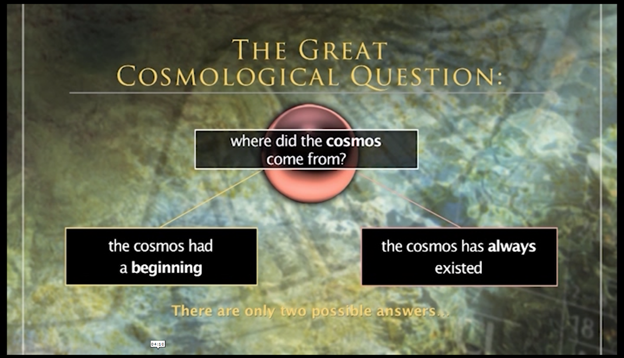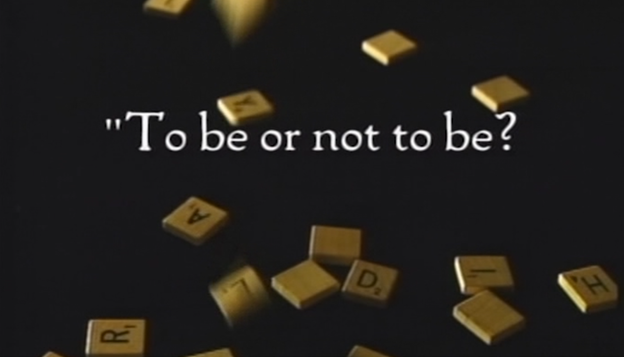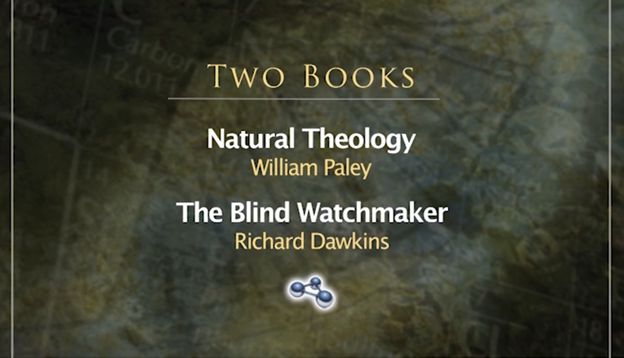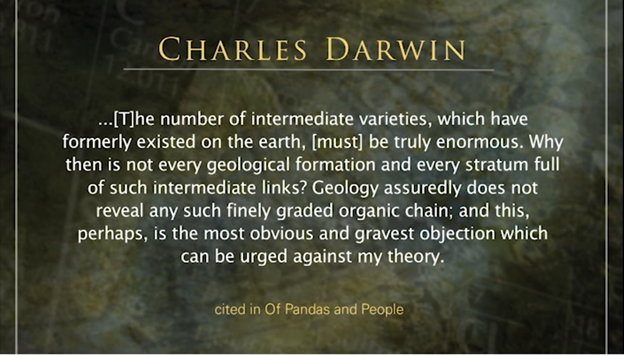This post is part 5 of a 12 part series about The Truth Project, an in-depth Christian Worldview experience led by Del Tackett and published by Focus on the Family.
Part 1: Science: What is True?
In this fifth part of The Truth Project, Del Tackett addresses the topic of science. Before delving into the topic, he opens the session with a reading of Psalm 19:1-4:
The heavens declare the glory of God,
and the sky above proclaims his handiwork.
Day to day pours out speech,
and night to night reveals knowledge.
There is no speech, nor are there words,
whose voice is not heard.
Their voice goes out through all the earth,
and their words to the end of the world.
This passage reminds us of the enormous size of the universe and examines the virtual “voices” of creation declaring the glories of God. God has spoken. He has spoken in the world he made according to the Psalmist. The immensity of creation can be overwhelming on a clear, dark night when you look up in the sky and gaze upon the countless stars above.
And yet, not everyone can see God’s handiwork in creation. Many people reject God’s witness in his created world through a sinful suppression of an obvious reality. The Apostle Paul makes it clear in Romans 1. “For what can be known about God is plain to them, because God has shown it to them.” (Romans 1:19). And why do these unbelievers not see God’s plain revelation in nature? Because they “suppress the truth” in unrighteous living (Romans 1:18).
Cosmological & Metaphysical Questions
Not every one acknowledges God in his creation. Whether or not the people see God’s glory in what he has made, they still must account for certain aspects of creation. One of the chief questions is where did the cosmos come from? This question has stumped philosophers for centuries. There are two primary possibilities about the origin of the universe. For one, the universe had a beginning. And second, the universe always existed. If we are to acknowledge the existence of the universe, we must acknowledge these two possibilities.

In addition to cosmological questions, there are more foundational metaphysical questions. After all, the universe is important but certain preconditions must precede the existence of the universe. Whether someone acknowledges the existence of God, they must answer other questions about the nature of the universe. Namely…
- Why is there order rather than chaos?
- Why is there life rather than deadness?
- Why is there music?
In all of these questions, the naturalist (atheist) must appeal to a distant past when things like order, life, and music came into being. In fact, “time” has virtual God-like powers within naturalism. As Nobel Laureate George Wald once wrote…
“ … given enough time it will almost certainly happen at least once … . Time is in fact the hero of the plot … . Given so much time, the ‘impossible’ becomes possible, the possible probable, and the probable virtually certain. One has only to wait; time itself performs the miracles.”
In the false worldview of naturalism, time is a powerful component. Whatever unbelievable sort of thing that naturalism requires such as getting order from chaos, life from non-life, or music from a cacophony of a random universe, time will create it all.
Definition and Foundation for Science
With that philosophical background on science, Tackett then defines science. According to the Oxford English Dictionary, “science” is the systematic study of the structure and behaviour of the physical and natural world through observation and experiment.” In theory, the scientific establishment does aim to understand the natural world through observation and experiment.
Early scientists did aim to do such things for a good reason. Many believed in God. In other words, they assumed a solid grounding for their scientific investigations as being supported by a creator who made the world and ordered everything. Johannes Kepler once wrote, “The chief aim of all investigations of the external world should be to discover the rational order and harmony which has been imposed on it by God.” To Kepler, God made the world and we should expect to find order in such a world.
Randomness vs. Design
But order is not what the naturalist should expect to find. In his worldview, he should find randomness. Naturalism teaches the universe should have birthed chaos, not organized information. But the naturalist doesn’t find chaos when he looks at the universe.
Tackett illustrates the order we find in the universe with another video clip comparing how the information in the cell for a single protein is similar to a line from William Shakespeare’s Hamlet, “To be or not to be.” If a person were to drop Scrabble letters randomly on a table, how long would it take for the letters “To be or not to be” to form on the table? Answer: a long time.

And yet, the information that’s found in a single protein for a simple-celled organism would fill hundreds of books – far more information than is found in a single line from Shakespeare. So why would we expect all that order to randomly appear (and function) in proteins, cells, and organisms? The ability for randomness to create such order strains at credulity. And this is why the Scripture declares, “The fool says in his heart, “There is no God.” (Psalm 14:1).
Scientific Theories & Darwin’s Evolution
Despite the existence of all this information, the principle of randomness creating specified complexity is what modern biology is built upon. Charles Darwin’s understanding of gradual evolution outlined in The Origin of Species by Means of Natural Selection (1859) takes for granted the universe is chaotic but eventually creates complex biological organisms. Darwin’s understanding of evolution has become the most influential scientific theory in modern civilization. The theory itself had a humble beginning.
Darwin’s evolution by means of natural selection started as a hypothesis. This hypothesis proposed that all organisms are all related to each other biologically. Through various observations, scientists eventually confirmed the hypothesis and elevated it to a theory. The theory is a working assumption in research. After a while, the theory becomes so accepted that it’s elevated to a scientific law. At this point in biological science, Darwin’s theory is basically viewed as a law. Here are a few quotes that illustrate the law-like, non-theoretical understanding of evolution in the majority scientific community:
- Sir Julian Huxley: “Darwin’s theory is…no longer a theory, but a fact…Darwinianism has come of age so to speak. We are no longer having to bother about establishing the fact of evolution.” (Source: David Noebel, Understanding the Times)
- Isaac Asimov: “Today, although many educators play it safe by calling evolutionary ideas ‘theory’ instead of ‘fact,’ there is no reputable biologist who doubts that species, including Homo sapiens, have developed with time, and that they are continually, though slowly, changing.” (Source: Isaac Asimov, The Wellsprings of Life)
- Carl Sagan: “Evolution is a fact amply demonstrated by the fossil record and by contemporary molecular biology. Natural selection is a successful theory devised to explain the fact of evolution.” (Source: Carl Sagan, The Dragons of Eden)
- Richard Dawkins: “It is absolutely safe to say that if you meet somebody who claims not to believe in evolution, that person is ignorant, stupid, or insane (or wicked, but I’d rather not consider that).” (Source: Council for Democratic and Secular Humanism, 2001)
The Design Argument
Though the above scientists echo the majority scientific consensus regarding evolution, their voices are not unanimous in the scientific community. Many scientists have expressed problems with evolutionary ideas. The entire modern Intelligent Design (ID) movement led by PhD scientists has opposed evolutionary teaching as even a workable scientific theory. Tackett has introduced several prominent ID proponents including Stephen Meyer, David Berlinski, and Jonathan Wells.
But the first ID proponent could be William Paley (1743 – 1805). Paley’s forwarded an argument for the existence of God from design. In this argument, he reasoned that a thinking person would never stumble upon a pocket watch in the moors and conclude that the natural elements constructed it. The face of the watch, the numbers, the mechanics, or casing of the watch could never be built by chance. In the same way, thinking people should not conclude that our complex biological order in every organism happened by chance.

People know design when they see it. Even naturalists can see design in the things God has made. Charles Darwin once wrote, “I remember well the time when the thought of the eye made me cold all over, but I have got over this stage of the complaint, and now small trifling particulars of structure often make me very uncomfortable. The sight of a feather in a peacock’s tail, whenever I gaze at it, makes me sick.” (Source: Letter to Asa Gray)
Why did a peacock feather make Darwin sick? Because intuitively, he knew it didn’t create itself. Instead, Darwin somehow instinctively knew it had a creator.
Part 2: Science: What is True?
Dr. Tackett opens the 2nd part of Science: What is True? with a short video of a girl explaining blood clotting. The montage of animation and explanation is meant to illustrate how much happens when someone cuts their finger. In general, a cut results in bleeding which eventually results in a clot at the cut. It’s an amazing process.

But evolutionists think blood clotting is a process that developed over millions of years. Moreover, every living organism came about through random mutation and natural selection over that period of time in that understanding. According to evolutionists, it’s demonstrable. Carl Sagan once said “Evolution is a fact amply demonstrated by the fossil record and by contemporary molecular biology.” In fact, there are problems in both of these areas for evolutionists, not so much ample demonstration.
The Molecular Biology Problem for Evolution
The first major problem for evolution relates to molecular biology. Darwin himself acknowledged that molecular biology could pose a problem for evolution. Charles Darwin once wrote, “If it could be demonstrated that any complex organ existed, which could not possibly have been formed by numerous, successive, slight modifications, my theory would absolutely break down.” These slight modifications happen in the basic building block of life, the cell. When Darwin wrote, the cell was understood to be a globule of indistinct life – a black box. But after 150+ years, we now know the cell as a house for multiple types of nanotechnology which demonstrate actions that boggle the mind.
For instance, the information found in a single strand of DNA for a single-celled amoeba would fill a thousand sets of the Encyclopedia Britannica. And this technology and information has only one known source: intelligent design. Slight modifications cannot progressively create this masterful work – even in amoebas.
So there’s the information problem for evolutionists as well as the complexity problem. In fact, cells are so complex they can be described as irreducibly complex. Dr. Michael Behe helped explain this concept in a simple fashion by using a mouse trap. The mouse trap has a few parts, but each is required for the trap to function. Take one part away: the spring, the base, or the trigger and then the trap is rendered useless. That’s the problem with the cell. The cell is so complex, if you remove one major part it’s rendered useless. The cell is irreducibly complex. For evolution to be true, the cell would have had to self-assemble altogether at once with everything in place at the beginning – an impossible feat.
The Fossil Record Problem for Evolution
In addition, there’s another problem in the fossil record for evolution. The fossil record simply does not record any evolutionary process. Darwin himself admitted that the fossil record as it was understood in his day did not point to evolution when he said, “Geology assuredly does not reveal any such finely graded organic chain; and this, perhaps, is the most obvious and gravest objection which can be urged against my theory.”

The problem has not improved much since Darwin’s day. According to Dr. David Berlinski, there are at least 50,000 changes that are required for a land-dwelling creature to become a sea-dwelling creature. Berlinski asks an important question regarding those tens of thousands of required changes: why don’t we see evidence of these transitional forms in the fossil record?
Indeed, it’s an important question: where are the transitional forms in the fossil record if there are so many so-called transitional forms according to evolutionary theory? Some evolutionists actually admit the problem.
- Paleontologist Colin Patterson wrote, “I will lay it on the line – there is not one such [transitional] fossil for which one could make a watertight argument.”
- Paleontologist Stephen Jay Gould also wrote, “The extreme rarity of transitional forms in the fossil record persists as the trade secret of paleontology. The evolutionary trees that adorn our textbooks have data only at the tips and nodes of their branches; the rest is inference, however reasonable, not the evidence of the fossils.”
Icon of Evolution: Darwin’s Finches
Despite the fossil record problem for biological evolution, evolutionists continue to promote the theory. They do so through many stories and pictures, many of which have been debunked over the course of time (ex. Piltdown man, peppered moths, etc.). One of those “icons” that Darwin himself postulated: the Galapagos Islands finches. The evidence suggests finches beaks have evolved to adapt to new diets through natural selection. This is a small change, but one that has been extrapolated to suggest big evolutionary changes over time.
The problem with the finches icon is that the changes don’t tend to stick. New research into Darwin’s finches tells us that finch beaks do change over time depending on the diet of the finches, but they also change back to the original beak. So there’s less progression of beak variation and more of an oscillation between beak configuration depending on available finch food.
Application: Consequences of the Evolutionary Story
The problems of evolutionary theory are manifold. Not only does the molecular world not support evolution, but the fossil record cannot demonstrate evolutionary progress. But the problem is deeper than a lack of evidence. This theory undergirds an entire worldview that militates against Christianity. As Christians, we should be concerned when people adopt the theory of evolution.
American atheist G. Richard Bozarth wrote, “Evolution destroys utterly and finally the very reason Jesus’ earthly life was supposedly made necessary. Destroy Adam and Eve and original sin, and in the rubble you will find the sorry remains of the son of God…and if Jesus was not the redeemer who dies for our sins, and this is what evolution means, then Christianity is nothing.”
Dr. Tackett agrees with Bozarth. When someone accepts evolution, they necessarily accept methodological naturalism into their worldview. Evolution, whether intended or not, tends to imply atheism and contradicts Christianity. This is why we must combat the story of evolution as Christians.
Featured image by Louis Reed on Unsplash.



